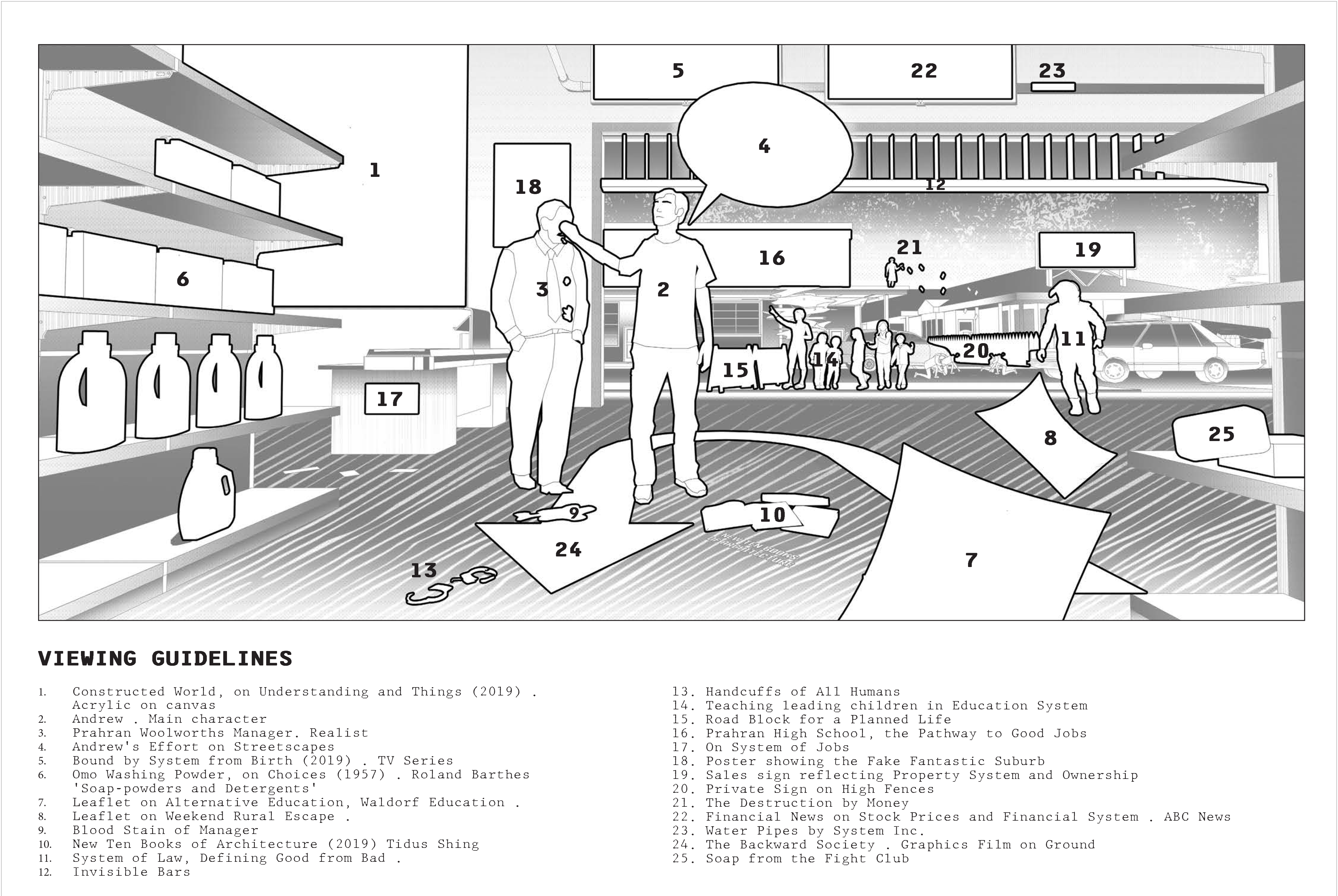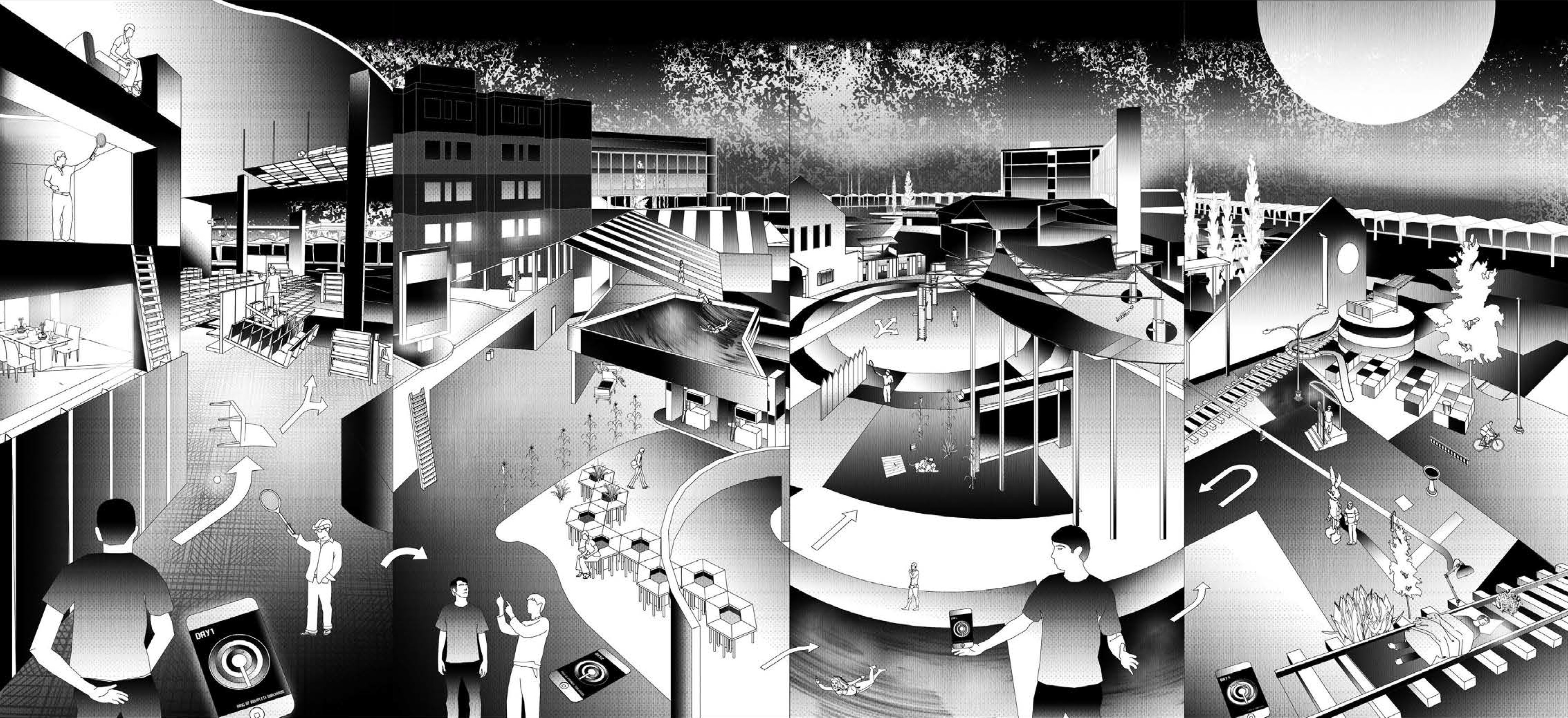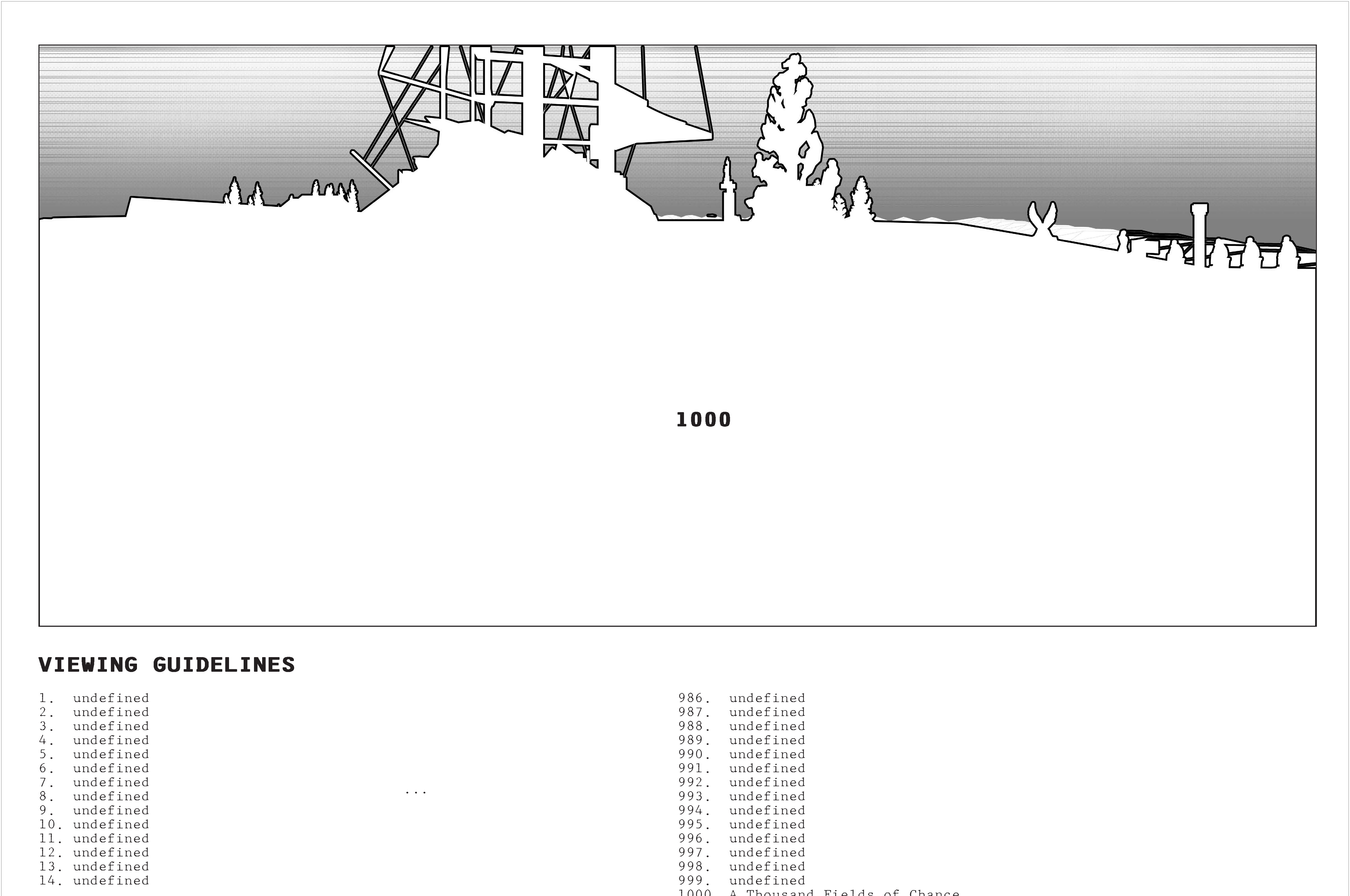A Thousand Fields of Chance
By Tidus Shing
We, as human beings, are living in a constructed world.
Our society is formed on the basis of social contracts and a collective understanding of how to act and behave.
This project looks at the possibility of living outside of this, through the speculation of a unique type of detention centre.
The story explores how the way we view things can shift and transform. It begins with the rigid world of the present, and ends with a new way of understanding our built environment, freed of definitions.
It embraces a return to chaos and a thousand fields of chance.
Here I introduce to you the main character, Andrew.










1. Andrew has been working hard by customising his house and the streetscapes that surround it. Unbeknownst to him, once born, you are bound by the system.
You think you have a choice.
But you are only guided towards specific choices provided.
You cannot be you. People use different methods to exclude themselves from the existing system, but at the end of the day, you still die within the systemof a planned society.
Andrew, who works at the Prahran Woolies, gets really angry when his manager says that it is a waste of time to try doing minor changes to the streets. He hits the manager in the face.
But the manager is right-he is still working at Woolies, he is still worrying about property prices, he is still planning his retirement.
He is within the system.
2. Andrew is arrested by the police and sent to the newly built Ashwood Detention Centre. It is nothing like what Andrew has seen on television. He is taken to a place called the Departure Hall, where the person on stage gives the following speech:
“This is a place called a Detention Centre,but it is not a normal one. You are not bad people. You are just people who could not fit into our society. This society defines itself by distinguishing good from bad.
It stands by a rigid definition of a proper way of living, without considering any other mode of life.
Here, you have a chance to live freely as a person, as yourself.
You now have the privilege of Exclusion.
Once you cross the bordersintothe detention centre, it is a stateless world. There are no more systems that restrict you: no laws, no jobs, no money, no property.
It is the undefined world of chance.”
The detention centre has adopted a completely new way of producing urban plans through the production of chance. The buildings, the ground cover, the items in the suburb, everything is swung through a centrifugal machine. Where we stand now, in the centre of the facility, is the border between the two worlds. It is the place which looks most similar to the existing world. The buildings here include schools, apartments,and hospitals - they are the results of the defined and known society.
However, their original functions are taken away.
It becomes an exhibition of the Excluded World. This is the point where the world starts to collapse - the collapse of meaning and collapse of concepts. It is now completely your decision to decide what you do. There is only one rule – every day, you must build or do something you haven’t done before, in order to experience the true power of free will. This is the Excluded World, and you are the Excluded Person.
The world is waiting for your reconstruction.
3. This is the first week of Andrew’s life in the detention centre. He does not have handcuffs, he can move freely. It is an unusual feeling that he no longer needs to work. In order to familiarise himself with this new world, he decides to take an intentional route through the spaces in the first four days. The spokes person had said that the further you get from the centre of the facility, the more fundamental and broken the pieces become. Andrew was experiencing this now, from a ring of relatively complete buildings, to a ring of partial buildings, to a ring of skeletal structures,and finally, to a ring of material debris.
He starts with observing how people creatively use these empty buildings to invent new ways of sleeping, eating, playing ball games and being alive. He starts interacting with others, he sleeps in a different location every day. But it is not until he sleeps on a train track, gazing at the stars for the first time in his life, that he feels pure joy. He realise she had become too used to the known. Instead of being restricted, this seems to be a better way to live.
4. Andrew remembers what the spokesperson had mentioned about the outer wall of this facility. Getting close to the wall he finds a wall camouflaged with multiple houses and various tools. There are so many people around taking stuff and rushing back. It almost looks like a lab of creation, a lab for the creation of the unknown. People start taking down pieces from the houses. They take down the window, they take down the wall, they take down the lightbulb. They put on mirrors, they put on a slide, they put on their imagination.
They test various methods of putting unexpected things together.
5. Through time, the separation between the rings collapse, and things move between the entire field of chances. There are no longer things that are recognisable, nor things that are defined. The field changes every day with the increasing number of people within. The naming and renaming of a place becomes a game between the prisoners. Names are no longer definite. In only half a year, Andrew can no longer fit into the previous world.
He has decided to stay for the rest of his life.
6. The detention centre organises open days every two weeks.
Today, Andrew is the guide for the local community in Ashwood.
The people are shocked by what they see. They see the familiar buildings in Ashwood being recomposed, shifted, and distorted. They cannot believe how attractive they find the ‘prisoner’ way of living. “Come to our side,” Andrew says at the end of the tour. People from Ashwood start moving in voluntarily. Ashwood is becoming empty. The Ashwood Detention Centreis no longer called a detention centre.
It is now renamed A Thousand Fields of Chance.
7. FINALE
Architecture and society are no longer defined through strict parameters. Instead, this new model of living offers the freedom of the undefined. The Thousand Fields of Chance provides a methodology of resetting all meaning.
It excludes architecture from the pre-defined, asking:
What could happen if humans were given complete mastery over their built environment?
Are you prepared to do what you really want today?
You think you have a choice.
But you are only guided towards specific choices provided.
You cannot be you. People use different methods to exclude themselves from the existing system, but at the end of the day, you still die within the systemof a planned society.
Andrew, who works at the Prahran Woolies, gets really angry when his manager says that it is a waste of time to try doing minor changes to the streets. He hits the manager in the face.
But the manager is right-he is still working at Woolies, he is still worrying about property prices, he is still planning his retirement.
He is within the system.
2. Andrew is arrested by the police and sent to the newly built Ashwood Detention Centre. It is nothing like what Andrew has seen on television. He is taken to a place called the Departure Hall, where the person on stage gives the following speech:
“This is a place called a Detention Centre,but it is not a normal one. You are not bad people. You are just people who could not fit into our society. This society defines itself by distinguishing good from bad.
It stands by a rigid definition of a proper way of living, without considering any other mode of life.
Here, you have a chance to live freely as a person, as yourself.
You now have the privilege of Exclusion.
Once you cross the bordersintothe detention centre, it is a stateless world. There are no more systems that restrict you: no laws, no jobs, no money, no property.
It is the undefined world of chance.”
The detention centre has adopted a completely new way of producing urban plans through the production of chance. The buildings, the ground cover, the items in the suburb, everything is swung through a centrifugal machine. Where we stand now, in the centre of the facility, is the border between the two worlds. It is the place which looks most similar to the existing world. The buildings here include schools, apartments,and hospitals - they are the results of the defined and known society.
However, their original functions are taken away.
It becomes an exhibition of the Excluded World. This is the point where the world starts to collapse - the collapse of meaning and collapse of concepts. It is now completely your decision to decide what you do. There is only one rule – every day, you must build or do something you haven’t done before, in order to experience the true power of free will. This is the Excluded World, and you are the Excluded Person.
The world is waiting for your reconstruction.
3. This is the first week of Andrew’s life in the detention centre. He does not have handcuffs, he can move freely. It is an unusual feeling that he no longer needs to work. In order to familiarise himself with this new world, he decides to take an intentional route through the spaces in the first four days. The spokes person had said that the further you get from the centre of the facility, the more fundamental and broken the pieces become. Andrew was experiencing this now, from a ring of relatively complete buildings, to a ring of partial buildings, to a ring of skeletal structures,and finally, to a ring of material debris.
He starts with observing how people creatively use these empty buildings to invent new ways of sleeping, eating, playing ball games and being alive. He starts interacting with others, he sleeps in a different location every day. But it is not until he sleeps on a train track, gazing at the stars for the first time in his life, that he feels pure joy. He realise she had become too used to the known. Instead of being restricted, this seems to be a better way to live.
4. Andrew remembers what the spokesperson had mentioned about the outer wall of this facility. Getting close to the wall he finds a wall camouflaged with multiple houses and various tools. There are so many people around taking stuff and rushing back. It almost looks like a lab of creation, a lab for the creation of the unknown. People start taking down pieces from the houses. They take down the window, they take down the wall, they take down the lightbulb. They put on mirrors, they put on a slide, they put on their imagination.
They test various methods of putting unexpected things together.
5. Through time, the separation between the rings collapse, and things move between the entire field of chances. There are no longer things that are recognisable, nor things that are defined. The field changes every day with the increasing number of people within. The naming and renaming of a place becomes a game between the prisoners. Names are no longer definite. In only half a year, Andrew can no longer fit into the previous world.
He has decided to stay for the rest of his life.
6. The detention centre organises open days every two weeks.
Today, Andrew is the guide for the local community in Ashwood.
The people are shocked by what they see. They see the familiar buildings in Ashwood being recomposed, shifted, and distorted. They cannot believe how attractive they find the ‘prisoner’ way of living. “Come to our side,” Andrew says at the end of the tour. People from Ashwood start moving in voluntarily. Ashwood is becoming empty. The Ashwood Detention Centreis no longer called a detention centre.
It is now renamed A Thousand Fields of Chance.
7. FINALE
Architecture and society are no longer defined through strict parameters. Instead, this new model of living offers the freedom of the undefined. The Thousand Fields of Chance provides a methodology of resetting all meaning.
It excludes architecture from the pre-defined, asking:
What could happen if humans were given complete mastery over their built environment?
Are you prepared to do what you really want today?
︎︎︎
Note from the editor:
Tidus’ piece, ‘A Thousand Fields of Chance’ explores the theme of SHIFT through the speculation of a world where the boundaries and functions of architecture are undefined.
It questions the way we categorise, label and define the spaces around us, encouraging us to recognise our ‘normal’ way of living as ultimately unsatisfactory.
The current pandemic has forced the world to stop in its tracks, creating the perfect opportunity to re-examine the way our society is built, and the fundamental flaws that have been exposed through this rearrangement of the familiar and the defined.
Tidus’ piece “begins with the rigid world of the present, and ends with a new way of understanding our built environment, freed of definitions. It embraces a return to chaos and a thousand fields of chance.”
This is a story about Andrew, who works at the Prahran Woolies.
Note from the editor:
Tidus’ piece, ‘A Thousand Fields of Chance’ explores the theme of SHIFT through the speculation of a world where the boundaries and functions of architecture are undefined.
It questions the way we categorise, label and define the spaces around us, encouraging us to recognise our ‘normal’ way of living as ultimately unsatisfactory.
The current pandemic has forced the world to stop in its tracks, creating the perfect opportunity to re-examine the way our society is built, and the fundamental flaws that have been exposed through this rearrangement of the familiar and the defined.
Tidus’ piece “begins with the rigid world of the present, and ends with a new way of understanding our built environment, freed of definitions. It embraces a return to chaos and a thousand fields of chance.”
This is a story about Andrew, who works at the Prahran Woolies.
